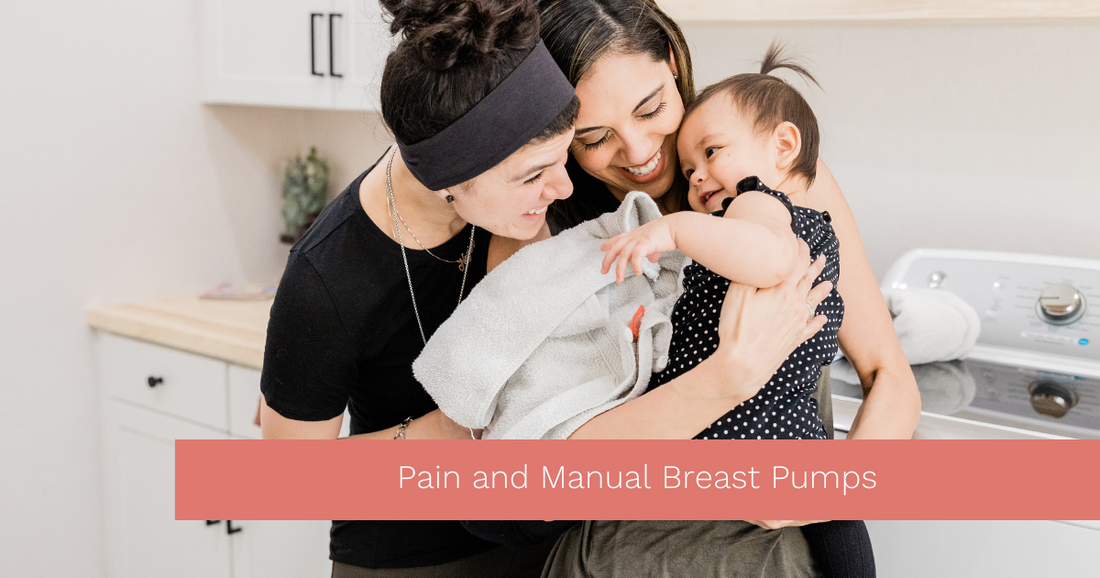Pain and Manual Breast Pumps
Mommy Care Team
We love manual pumps. They're a great tool for pumping moms and we always recommend having one whether you plan to nurse, pump, or some combination of the two. We'll get into more benefits later in this post, but let's dive into some common causes of pain.
Ways Manual Pumps Can Cause Pain
For something that seems simple, pumping can be pretty complicated. There are a lot of nuances that can either improve your pumping session or cause it to be a source of pain and frustration. Don’t pump in the dark Mama. We’ve put together a series of blog posts that provide pumping moms with helpful, actionable tips that can improve and even save your pumping journey.
Alignment
Hold out your forearm. Now take a gift card or credit card and rub the edge over your skin again and again. Starting to feel the friction? If you are not centering your nipple in the tunnel of your breast pump flange, this is effectively what you are doing to some of the most sensitive skin on your body. Ouch!
Alignment is so important that we made our breast pump cushions clear to help moms take the guesswork out of placement. Check them out here and see for yourself.
Flange Size:
Wearing a shoe that’s too big or too small can have consequences for your feet. Your feet are either floating or too restricted. Picking the appropriate flange size for your manual breast pump is just as important as paying attention to your shoe size. Not all breasts and nipples are the same size. And unlike our feet, our nipple size may change over time due to a number of different factors.
Using a flange size that is too small can create painful friction and compress your milk ducts. This makes pumping harder and can reduce your overall output. Restricting your output over a period of time can have the unintentional side effect of killing your milk supply. Using a flange that is too big can have a similar effect because it allows too much of your areolar tissue to be pulled into the flange. Get this free downloadable ruler from BeauGen and stick it into your pump bag.
Improper Use
Use something too much, or pick a setting that’s too strong and it can have adverse effects. The same is true for manual breast pumps. The beauty of a manual pup is that you have total control over the suction strength, pattern, and duration. But be too eager and this freedom can bite you in the…nipple.
Pulling the lever on your manual breast pump creates suction. First start with smaller, shorter pulls on the lever to mimic the letdown mode of an electric breast pump, or your baby suckling. Once your let down is initiated, you can switch to longer, stronger pulls. Be careful not to overdo it. Pay attention to the way your body responds and adjust accordingly. Need more info on let downs? Check out this post.
Ways Manual Pumps Can Help with Pain
Now that we covered the cringy, if not potentially scary side of manual pumps, let us assure you that these things can be a lifesaver for your pumping journey. Manual pumps put you in control over the suction. This means that you can use the suction to help troubleshoot problems. For example, manual breast pumps are great for clearing clogs and blockages because you can pinpoint their location and target the suction at that spot.
Manual pumps are also smaller. Smaller, and a lack of a motor means a few different added benefits. They’re lighter, and easier to carry around. Their lack of need for a power source means that they work anywhere. Keeping one in your car can ensure that you are never too far from your pump. Keeping one on hand can also allow you to pup even when the power is out. They’re quieter, which is great for added privacy, or not waking a sleeping baby. For more benefits of manual breast pumps check out or top ten reasons for keeping them on hand.
